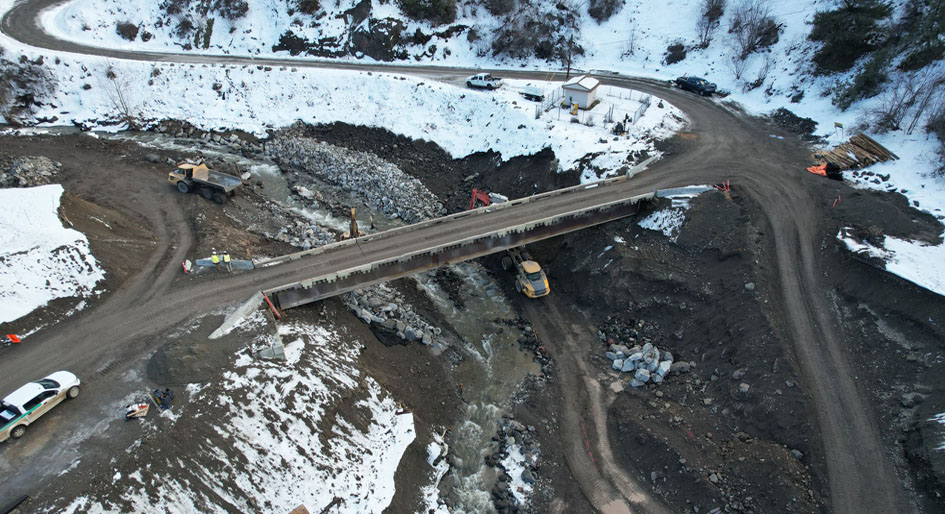The impact to B.C.’s key highway corridors caused by the November atmospheric river events was devastating. Bridges and roads were heavily damaged by washouts, flooding or landslides following record-breaking rainfall.
“The November weather event caused unprecedented and catastrophic damage to our highways, resulting in communities cut off and major supply chain disruptions,” said Jennifer Fraser, executive project director for the Highway Reinstatement Program.
Fraser was a speaker at this year’s Transportation Conference, hosted by the Association of Engineering Consulting Companies. Representatives from the B.C. Ministry of Transportation (MoTI) provided an overview of the damage and repairs completed after the storms and discussed the long term strategy to ensure resiliency.
“Since the event there’s been a massive mobilization of people and equipment. Contractors set to work with engineers to assess the damage and formulate a plan,” said Fraser, who discussed the work completed on Highway 1, the Coquihalla and Highway 8.
Repairs included installing temporary bridges, rep-rap, temporary spans and reinforcing and rebuilding embankments and more. On the Coquihalla alone, the repairs required more than 200 pieces of heavy equipment and 300 workers going around the clock. They moved 400 cubic metres of fill and blasted more than 130 cubic metres of rock (equivalent to 50 Olympic size pools)
“The level of effort, creativity, and real time engineering to repair this site was repeated throughout the corridor with the Coquihalla opening to commercial vehicles on December 20,” said Fraser. “Key to achieving this milestone was the planning that went into figuring out how we could, as quickly as possible, develop designs and mobilize equipment past the first damaged bridges on either end…to work on this 130km stretch.”
Now that temporary repairs are in place, the province is looking at the next phase for permanent repairs and establishing engineering standards.
Ian Pilkington, chief engineer for the ministry, spoke about what engineering standards should be used to ensure resiliency in infrastructure for future climate events. It’s a question the ministry asked a decade ago.
“At that time, future climate projections for the world were being created by international scientists but they were at a very high level,” he said. “This gave us a sense of the future climate conditions but not to the level of detail to analyze how climate change would impact our infrastructure here on the ground in B.C.”
He explained the Public Infrastructure Engineering Vulnerability Committee established by Engineers Canada, assesses the vulnerability of public infrastructure to climate change impacts.
“Using this protocol a public body can determine how future climate events will affect their infrastructure and subsequently how you can mitigate these event,” said Pilkington.
The protocol was used in five different regions in the province to understand vulnerabilities and what climate information was needed for analysis.
“What we learned was our design formulas and methodologies were still valid but what really changed is input data. We can no longer rely on historical data. We now must use future climate prediction models for the right design parameters,” he said.
The ministry created a policy several years ago that all designs undertaken on provincial highway infrastructure must consider future climate events including new structures, rehabilitations or rebuilding after an event like the three damaged corridors.
Pilkington advised an online interactive portal is available to assist designers and municipalities in their infrastructure planning and other various materials are regularly updated.
What comes next for B.C.’s highways was addressed by Kevin Volk, MoTI assistant deputy minister.
“Central to that is the ministry and the province having a strategy for reconstruction, for resiliency and constructing a system that will stand the test of time, future impacts of storms and climate change on our system,” said Volk.
The ministry is considering five principles to balance current emergency work to restore the system and long-term projects needed to strategically improve corridor-wide resiliency. Volk said decisions and prioritization are based on B.C.’s highways as an integrated system.
“When we’re assessing and prioritizing investments and also how we’re going to design and build our highways in the future, the role of the individual corridors in the highway system and the impacts to the highway systems need to be considered and lead to prioritizing,” he said.
Vulnerability is a key principle and the flooding event demonstrated clearly the highways in the southwest linking the coast to the interior needed to be addressed. These are areas that link to the bulk of the Lower Mainland’s population and Canada’s busiest port.
“It was essentially the western coast of Canada being cut off from the rest of the province,” said Volk. “The economic and community impacts of what happened in November were catastrophic and warrant the immediate prioritization of work….mainly for Highways 99, 3, 5 and 1.”
Volk said the focus now is on what reconstruction work can be planned and completed this year. RFQs for prequalified firms closed in December. RFPs will be coming out in the next couple of months.
“As projects are identified, we will quickly put out RFPs — much shorter RFPs — where design and construction firms would partner and submit a proposal,” said Volk. “It would be a collaborative process where the ministry, designer and builder work to finalize scope, budget and schedule together. Time is of the essence and that is the most cost and time-effective process to get these projects rolling as quickly as possible.”
Cheryl Mah is managing editor of Construction Business.










